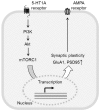Role of Serotonergic System in the Antidepressant Actions of mGlu2/3 Receptor Antagonists: Similarity to Ketamine
- PMID: 30871246
- PMCID: PMC6470808
- DOI: 10.3390/ijms20061270
Role of Serotonergic System in the Antidepressant Actions of mGlu2/3 Receptor Antagonists: Similarity to Ketamine
Abstract
Numerous studies have demonstrated the antidepressant effects of group II metabotropic glutamate (mGlu2/3) receptor antagonists in various rodent models. Importantly, it has been shown that the antidepressant effects of mGlu2/3 receptor antagonists in rodent models are similar to those of ketamine, which exerts rapid and long-lasting antidepressant effects in patients with major depressive disorders, including patients with treatment-resistant depression. In addition, the synaptic mechanisms underlying the effects of mGlu2/3 receptor antagonists are reported to be similar to those underlying the effects of ketamine. The roles of the serotonergic system in the antidepressant effects of mGlu2/3 receptor antagonists have recently been demonstrated. Moreover, it was investigated how mGlu2/3 receptor antagonists interact with the serotonergic system to exert antidepressant effects. Notably, the same neural mechanisms as those underlying the effects of ketamine may be involved in the antidepressant actions of the mGlu2/3 receptor antagonists. In this review, we shall summarize the antidepressant potential of mGlu2/3 receptor antagonists and their mechanisms of action in comparison with those of ketamine. In particular, we shall focus on the roles of the serotonergic system in the antidepressant actions of mGlu2/3 receptor antagonists.
Keywords: 5-HT1A receptor; AMPA receptor; antidepressant; ketamine; mGlu2/3 receptor antagonist; medial prefrontal cortex; serotonin.
Conflict of interest statement
Shigeyuki Chaki and Kenichi Fukumoto are employees of Taisho Pharmaceutical Co., Ltd. The authors declare no conflict of interest.
Figures


Similar articles
-
mGlu2/3 receptor as a novel target for rapid acting antidepressants.Adv Pharmacol. 2020;89:289-309. doi: 10.1016/bs.apha.2020.04.001. Epub 2020 May 22. Adv Pharmacol. 2020. PMID: 32616210 Review.
-
mGlu2/3 receptor antagonists for depression: overview of underlying mechanisms and clinical development.Eur Arch Psychiatry Clin Neurosci. 2023 Oct;273(7):1451-1462. doi: 10.1007/s00406-023-01561-6. Epub 2023 Jan 30. Eur Arch Psychiatry Clin Neurosci. 2023. PMID: 36715750 Review.
-
mGlu2/3 receptor antagonists.Adv Pharmacol. 2019;86:97-120. doi: 10.1016/bs.apha.2019.03.004. Epub 2019 Apr 24. Adv Pharmacol. 2019. PMID: 31378257 Review.
-
The Antidepressant Effects of an mGlu2/3 Receptor Antagonist and Ketamine Require AMPA Receptor Stimulation in the mPFC and Subsequent Activation of the 5-HT Neurons in the DRN.Neuropsychopharmacology. 2016 Mar;41(4):1046-56. doi: 10.1038/npp.2015.233. Epub 2015 Aug 6. Neuropsychopharmacology. 2016. PMID: 26245499 Free PMC article.
-
Serotonin-1A receptor stimulation mediates effects of a metabotropic glutamate 2/3 receptor antagonist, 2S-2-amino-2-(1S,2S-2-carboxycycloprop-1-yl)-3-(xanth-9-yl)propanoic acid (LY341495), and an N-methyl-D-aspartate receptor antagonist, ketamine, in the novelty-suppressed feeding test.Psychopharmacology (Berl). 2014 Jun;231(11):2291-8. doi: 10.1007/s00213-013-3378-0. Epub 2014 Jan 9. Psychopharmacology (Berl). 2014. PMID: 24402133
Cited by
-
5-Hydroxytryptophan Reduces Levodopa-Induced Dyskinesia via Regulating AKT/mTOR/S6K and CREB/ΔFosB Signals in a Mouse Model of Parkinson's Disease.Biomol Ther (Seoul). 2023 Jul 1;31(4):402-410. doi: 10.4062/biomolther.2022.141. Epub 2023 Mar 15. Biomol Ther (Seoul). 2023. PMID: 36918741 Free PMC article.
-
Ketamine: The final frontier or another depressing end?Behav Brain Res. 2020 Apr 6;383:112508. doi: 10.1016/j.bbr.2020.112508. Epub 2020 Feb 1. Behav Brain Res. 2020. PMID: 32017978 Free PMC article. Review.
-
Ketamine and serotonergic psychedelics: An update on the mechanisms and biosignatures underlying rapid-acting antidepressant treatment.Neuropharmacology. 2023 Mar 15;226:109422. doi: 10.1016/j.neuropharm.2023.109422. Epub 2023 Jan 13. Neuropharmacology. 2023. PMID: 36646310 Free PMC article. Review.
-
Understanding the Biological Relationship between Migraine and Depression.Biomolecules. 2024 Jan 30;14(2):163. doi: 10.3390/biom14020163. Biomolecules. 2024. PMID: 38397400 Free PMC article. Review.
-
Evaluation of the Safety, Tolerability, and Pharmacokinetic Profiles of TP0473292 (TS-161), A Prodrug of a Novel Orthosteric mGlu2/3 Receptor Antagonist TP0178894, in Healthy Subjects and Its Antidepressant-Like Effects in Rodents.Int J Neuropsychopharmacol. 2022 Feb 11;25(2):106-117. doi: 10.1093/ijnp/pyab062. Int J Neuropsychopharmacol. 2022. PMID: 34534292 Free PMC article. Clinical Trial.
References
-
- Newport D.J., Carpenter L.L., McDonald W.M., Potash J.B., Tohen M., Nemeroff C.B., APA Council of Research Task Force on Novel Biomarkers and Treatments Ketamine and Other NMDA Antagonists: Early Clinical Trials and Possible Mechanisms in Depression. Am. J. Psychiatry. 2015;172:950–966. doi: 10.1176/appi.ajp.2015.15040465. - DOI - PubMed
-
- Feyissa A.M., Woolverton W.L., Miguel-Hidalgo J.J., Wang Z., Kyle P.B., Hasler G., Stockmeier C.A., Iyo A.H., Karolewicz B. Elevated level of metabotropic glutamate receptor 2/3 in the prefrontal cortex in major depression. Prog. Neuropsychopharmacol. Biol. Psychiatry. 2010;34:279–283. doi: 10.1016/j.pnpbp.2009.11.018. - DOI - PMC - PubMed
Publication types
MeSH terms
Substances
LinkOut - more resources
Full Text Sources
Medical

